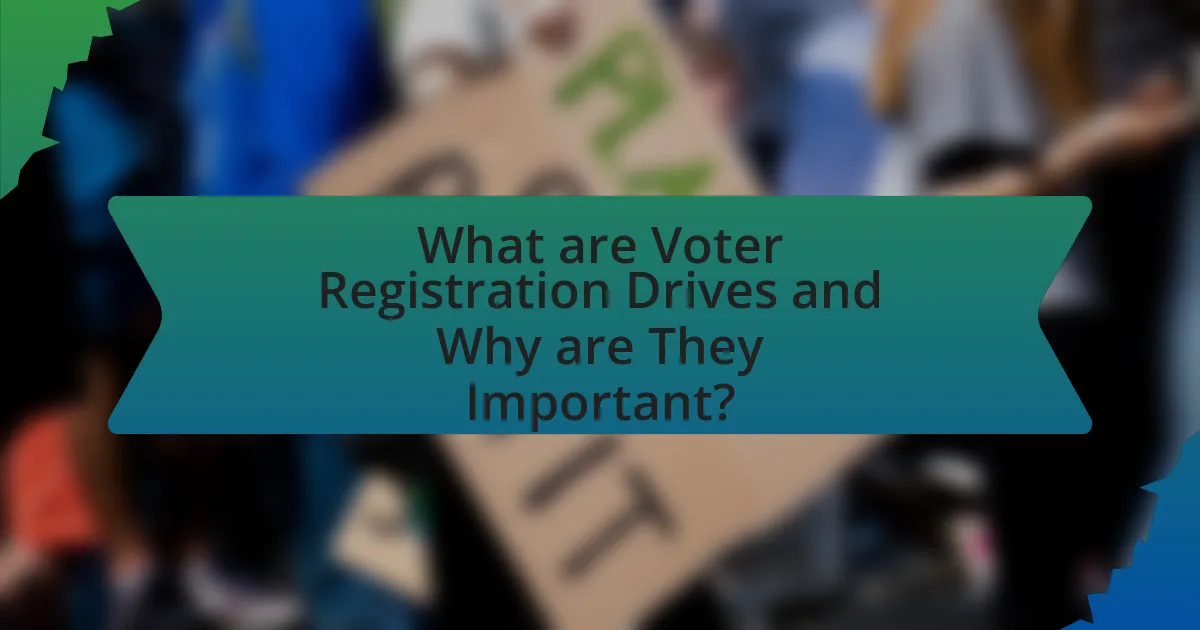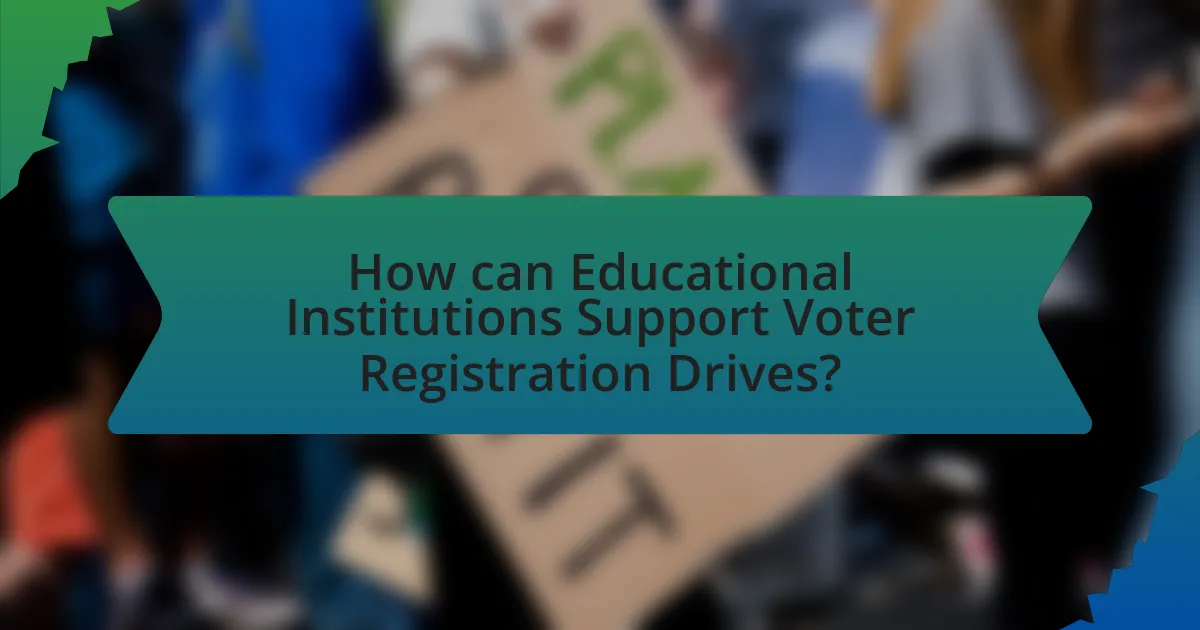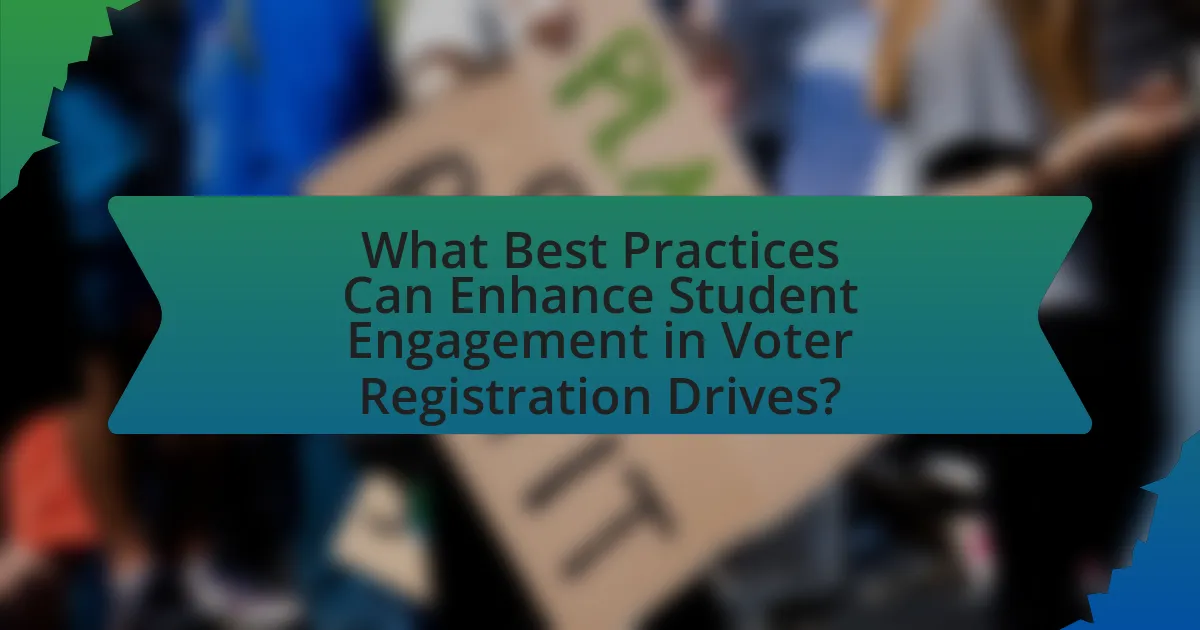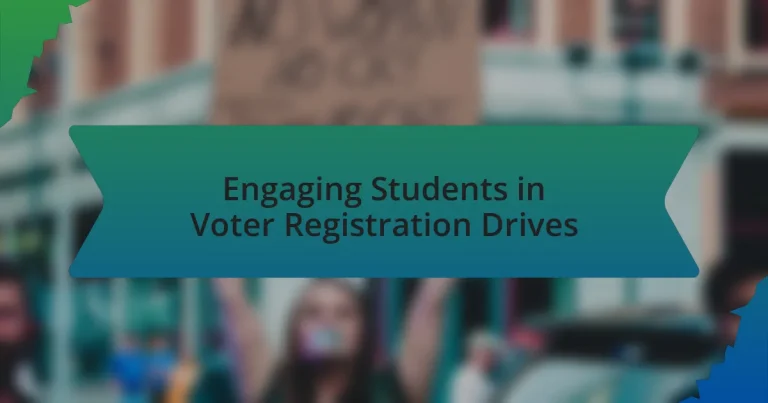Voter registration drives are organized initiatives aimed at increasing voter participation, particularly among underrepresented groups, including students. These drives play a crucial role in enhancing the democratic process by facilitating access to voter registration and providing educational resources about civic engagement. The article explores effective methods for engaging students, such as social media campaigns and on-campus events, while addressing challenges like apathy and competing priorities. It emphasizes the importance of student involvement in these drives, highlighting how active participation can lead to higher voter turnout and foster a culture of civic responsibility within educational institutions. Additionally, the article discusses best practices and resources that educational institutions can utilize to support and sustain voter registration efforts among students.

What are Voter Registration Drives and Why are They Important?
Voter registration drives are organized efforts to encourage and assist individuals in registering to vote. These drives are important because they increase voter participation, particularly among underrepresented groups, thereby enhancing the democratic process. For instance, according to the U.S. Census Bureau, states that implemented voter registration drives saw a significant increase in voter turnout, with some reporting increases of up to 10% in participation rates during elections. By facilitating access to registration, these drives help ensure that more citizens can exercise their right to vote, which is fundamental to a functioning democracy.
How do Voter Registration Drives engage students specifically?
Voter Registration Drives engage students specifically by providing accessible opportunities for them to register to vote and learn about the electoral process. These drives often take place on college campuses, where students can easily participate during events or classes, making the registration process convenient. Additionally, they incorporate educational components, such as workshops or informational sessions, that inform students about voting rights, the importance of civic engagement, and how their votes impact local and national issues. Research indicates that students who participate in these drives are more likely to vote, with studies showing that voter registration efforts can increase turnout rates among young voters by as much as 10-15%.
What methods are most effective in reaching students for voter registration?
The most effective methods for reaching students for voter registration include utilizing social media campaigns, organizing on-campus events, and partnering with student organizations. Social media platforms like Instagram and TikTok have proven to be particularly effective, as they engage students where they spend significant time online; for instance, a study by the Pew Research Center found that 84% of young adults use social media, making it a prime avenue for outreach. On-campus events, such as voter registration drives during orientation or in collaboration with popular campus activities, create direct engagement opportunities, as evidenced by a report from the National Association of Secretaries of State, which indicates that in-person events significantly increase registration rates. Additionally, partnerships with student organizations leverage existing networks and trust, enhancing outreach effectiveness, as shown in research by the Harvard Kennedy School, which highlights that peer influence is a critical factor in motivating students to register.
Why is student engagement crucial for the success of voter registration drives?
Student engagement is crucial for the success of voter registration drives because it significantly increases participation rates among young voters. Engaged students are more likely to understand the importance of voting and feel motivated to register and participate in elections. Research indicates that when students are actively involved in voter registration efforts, such as through peer-to-peer outreach or campus events, registration rates can increase by as much as 20%. This heightened engagement not only fosters a sense of civic responsibility but also creates a culture of voting within educational institutions, leading to long-term electoral participation.
What challenges do organizers face in engaging students?
Organizers face several challenges in engaging students for voter registration drives, primarily including apathy towards voting, lack of awareness about the registration process, and competing priorities such as academic commitments. A study by the U.S. Census Bureau indicated that only 50% of eligible voters aged 18-29 participated in the 2020 election, highlighting the widespread apathy among this demographic. Additionally, many students are unaware of the specific steps required to register, which can deter participation. Competing priorities, such as coursework and extracurricular activities, further limit the time and energy students can dedicate to voter registration efforts. These factors collectively hinder organizers’ ability to effectively engage students in the electoral process.
How can these challenges be overcome to improve student participation?
To overcome challenges and improve student participation in voter registration drives, institutions can implement targeted outreach strategies that resonate with students’ interests and values. Research indicates that personalized communication, such as peer-to-peer engagement and social media campaigns, significantly increases participation rates among young voters. For instance, a study by the Institute for Democracy & Higher Education found that campuses employing student-led initiatives saw a 20% increase in voter registration compared to traditional methods. By fostering a sense of community and providing accessible information, educational institutions can effectively enhance student involvement in the electoral process.
What role does campus culture play in student engagement with voter registration?
Campus culture significantly influences student engagement with voter registration by fostering an environment that encourages civic participation. A vibrant campus culture that prioritizes social responsibility and political awareness can lead to higher rates of voter registration among students. For instance, universities that host events like voter registration drives, debates, and discussions about civic issues create a sense of community and urgency around the electoral process. Research indicates that campuses with active student organizations focused on political engagement see a 20% increase in voter registration compared to those without such organizations. This demonstrates that a supportive campus culture not only raises awareness but also motivates students to take action regarding their voting rights.

How can Educational Institutions Support Voter Registration Drives?
Educational institutions can support voter registration drives by providing resources, organizing events, and facilitating access to registration information. For instance, colleges and universities can host voter registration fairs on campus, where students can easily register to vote and learn about the voting process. According to the National Association of Secretaries of State, educational institutions that actively promote voter registration can significantly increase participation rates among young voters, who historically have lower turnout. Additionally, institutions can collaborate with local election offices to ensure students receive accurate information and assistance, further enhancing the effectiveness of these drives.
What initiatives can schools implement to promote voter registration?
Schools can implement initiatives such as voter registration drives, educational workshops, and partnerships with local election offices to promote voter registration. Voter registration drives can be organized during school events, allowing students to register on-site, while educational workshops can inform students about the voting process, the importance of civic engagement, and how to register. Collaborating with local election offices can provide resources and support, ensuring that students have access to accurate information and assistance. These initiatives have been shown to increase voter registration rates among young people, as evidenced by studies indicating that schools actively engaging in these activities see higher participation in elections among their students.
How can partnerships with local organizations enhance these initiatives?
Partnerships with local organizations can significantly enhance initiatives aimed at engaging students in voter registration drives by leveraging community resources and networks. Local organizations often have established relationships with students and can provide access to venues, volunteers, and promotional channels that increase participation. For instance, a study by the National Association of Secretaries of State found that community-based efforts can lead to a 20% increase in voter registration among young people when local organizations are involved. This collaboration not only amplifies outreach but also fosters a sense of community ownership over the electoral process, making students more likely to engage actively.
What resources are available for institutions to facilitate voter registration drives?
Institutions can utilize various resources to facilitate voter registration drives, including partnerships with organizations like the National Association of Secretaries of State, which provides tools and guidelines for effective registration efforts. Additionally, institutions can access online platforms such as Vote.org and Rock the Vote, which offer resources for creating registration campaigns, including customizable materials and outreach strategies. Research indicates that institutions that leverage these resources can significantly increase student voter registration rates, as evidenced by a study from the Institute for Democracy & Higher Education, which found that campuses using structured voter engagement strategies saw participation rates rise by up to 20%.
Why is it important for students to participate in voter registration drives?
It is important for students to participate in voter registration drives because their involvement helps increase overall voter turnout and fosters civic engagement among young people. Engaging students in these drives empowers them to exercise their democratic rights, as research indicates that individuals who register to vote are more likely to participate in elections. According to the U.S. Census Bureau, voter turnout among young people aged 18-29 increased from 45% in the 2014 midterm elections to 50% in 2018, highlighting the impact of targeted registration efforts. By participating in voter registration drives, students not only contribute to their communities but also develop a sense of responsibility and awareness regarding political issues that affect their lives.
What impact does student participation have on local and national elections?
Student participation significantly influences local and national elections by increasing voter turnout and shaping electoral outcomes. Research indicates that when students engage in the electoral process, they not only enhance their own voting rates but also encourage peers and community members to participate, leading to a more representative electorate. For instance, a study by the Institute for Democracy & Higher Education found that campuses with active voter registration drives saw turnout rates as high as 50% among students, compared to national averages of around 30% for young voters. This engagement can sway election results, particularly in close races, as seen in various local elections where student votes have been pivotal.
How does voter registration influence civic engagement among students?
Voter registration significantly enhances civic engagement among students by providing them with the opportunity to participate in the democratic process. When students register to vote, they become more informed about political issues, candidates, and the importance of their participation in elections. Research indicates that registered voters are more likely to engage in discussions about civic issues, attend town hall meetings, and participate in community service activities. For instance, a study by the National Study of Learning, Voting, and Engagement (NSLVE) found that institutions that actively promote voter registration see higher turnout rates among students, which correlates with increased civic involvement. This demonstrates that voter registration serves as a catalyst for broader civic engagement among the student population.

What Best Practices Can Enhance Student Engagement in Voter Registration Drives?
To enhance student engagement in voter registration drives, implementing interactive and educational activities is essential. Research indicates that hands-on experiences, such as workshops and peer-led discussions, significantly increase participation rates among students. For instance, a study by the National Association of Secretaries of State found that campuses that organized events like mock elections and informational sessions saw a 20% increase in voter registration compared to those that did not. Additionally, leveraging social media platforms to promote these events can effectively reach and engage students, as 70% of young voters reported being influenced by social media in their voting decisions.
How can technology be leveraged to improve voter registration efforts?
Technology can be leveraged to improve voter registration efforts by utilizing online platforms and mobile applications that streamline the registration process. These digital tools enable users to register quickly and efficiently, often allowing for real-time updates and verification of registration status. For instance, states like California have implemented online voter registration systems, which have led to a significant increase in registered voters; as of 2020, over 4 million Californians registered online since the system’s launch in 2012. Additionally, social media campaigns can raise awareness and encourage participation among younger demographics, further enhancing engagement in voter registration drives.
What digital tools are most effective for reaching students?
Social media platforms, particularly Instagram and TikTok, are the most effective digital tools for reaching students. These platforms have high engagement rates among younger demographics, with 71% of teens using Instagram and 60% using TikTok, making them ideal for campaigns aimed at student voter registration. Additionally, targeted ads on these platforms can effectively reach specific student populations, enhancing the likelihood of participation in voter registration drives.
How can social media campaigns boost awareness and participation?
Social media campaigns can significantly boost awareness and participation in voter registration drives by leveraging their vast reach and interactive features. These campaigns can disseminate information quickly to a large audience, engaging students through targeted messaging that resonates with their interests and values. For instance, a study by the Pew Research Center found that 69% of adults aged 18-29 use social media, making it an effective platform for reaching young voters. Additionally, social media allows for real-time interaction, enabling organizations to answer questions, dispel myths, and encourage immediate action, such as signing up for voter registration. This interactive engagement can lead to higher participation rates, as evidenced by the increase in voter turnout during elections where social media campaigns were actively employed.
What strategies can be employed to sustain student interest in voter registration?
To sustain student interest in voter registration, institutions can implement interactive educational programs that emphasize the importance of civic engagement. These programs can include workshops, guest speakers, and peer-led discussions that highlight the impact of voting on local and national issues. Research indicates that students are more likely to engage in voter registration when they perceive a direct connection between their participation and tangible outcomes, such as policy changes that affect their lives. Additionally, leveraging social media campaigns and gamification techniques can create a sense of community and competition, further motivating students to register and participate in elections.
How can follow-up initiatives maintain engagement beyond the registration drive?
Follow-up initiatives can maintain engagement beyond the registration drive by implementing ongoing communication strategies, such as regular updates, educational workshops, and social media interactions. These strategies keep participants informed and involved, fostering a sense of community and commitment to civic engagement. For instance, studies show that consistent outreach, like sending reminders about upcoming elections or providing information on voting procedures, significantly increases voter turnout among young people. Additionally, creating opportunities for participants to engage in discussions about civic issues or volunteer for related activities can further enhance their connection to the cause, as evidenced by research from the Center for Information & Research on Civic Learning and Engagement, which highlights the importance of sustained engagement in promoting active citizenship.
What role do peer-to-peer interactions play in sustaining interest?
Peer-to-peer interactions significantly enhance sustained interest in voter registration drives among students. These interactions create a sense of community and belonging, which motivates individuals to participate actively. Research indicates that social influence and peer encouragement can lead to increased engagement; for instance, a study by the American Political Science Review found that students are more likely to register and vote when encouraged by their peers. This dynamic fosters a supportive environment where students feel empowered to take action, thereby maintaining their interest in civic engagement initiatives.
What are the key takeaways for successfully engaging students in voter registration drives?
To successfully engage students in voter registration drives, organizations should prioritize peer-to-peer outreach, utilize social media platforms, and create an inclusive environment. Peer-to-peer outreach is effective because students are more likely to respond positively to their peers, as evidenced by a study from the Harvard Kennedy School, which found that peer influence significantly increases participation rates. Utilizing social media platforms allows for targeted messaging and engagement, as 90% of young adults use social media, making it a vital tool for reaching this demographic. Creating an inclusive environment ensures that all students feel welcome and represented, which is crucial for increasing registration rates among diverse populations.




